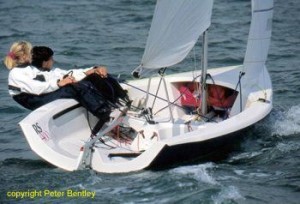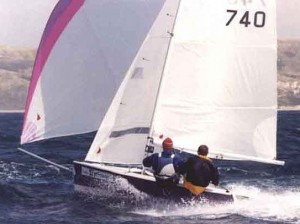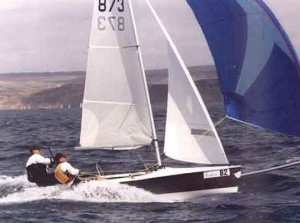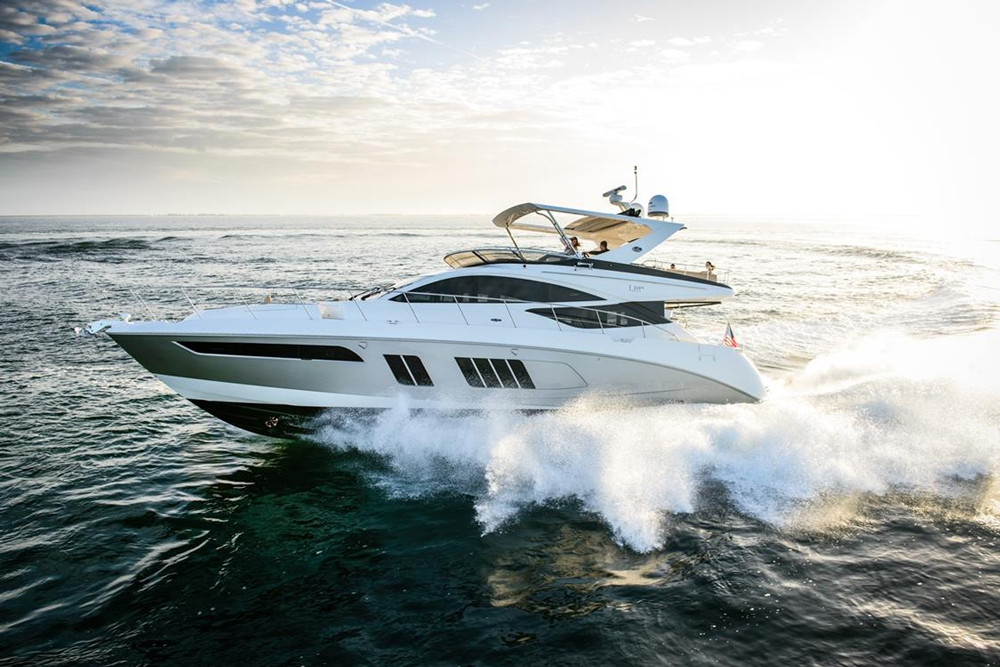RS400 - A Whole Lotta Boat
RS400.. and plenty of racing
 The RS400 is a 1990s incarnation of the classic two-man dinghy. Like the RS200, it's a product of the partnership between LDC and Phil Morrison, sharing many of the design features of the smaller boat - but this is more the beast for bigger people.
The RS400 is a 1990s incarnation of the classic two-man dinghy. Like the RS200, it's a product of the partnership between LDC and Phil Morrison, sharing many of the design features of the smaller boat - but this is more the beast for bigger people.
The madforsailing crew took the RS400 out on a moderate day in ideal sailing conditions - well, it had to happen eventually. The RS400 features a Proctor mast and Hyde sails on a powerful hiking hull, with an asymmetric that incorporates a swinging pole to allow the spinnaker to be projected a long way to windward of the mainsail. She should be manageable by anyone with basic sailing skills, and while not perhaps the boat for raw beginners, the RS400 is capable of providing some stunning performance.
Boat reviews always get off on the right foot when the subject is easy to rig, and the RS400 got her first high scores in this respect. Once sailing, it's clear that the modern design and construction has produced a boat with performance levels equal to or exceeding many trapeze boats. With a very generous beam, the RS400 is powerful upwind, points well and the harder the crew sits out, the faster she goes - which is a good thing or a bad thing, depending on your viewpoint.
Upwind steering is precise and sail sheet trimming is simple and efficient. The other major sail controls, notably vang, cunningham and jib luff tension, all lead to neatly recessed cleats in the wide centre thwart. Good scores for systems and layout.
Downwind the RS400 is a genuinely fast boat. Pop out the spinnaker and performance shoots into the top league. The swinging pole allows the RS400 to run quite deep, so low angles can be sailed effectively. Durability also looked good, our test boat was smart and very well presented for a hard working demonstrator.
We had to look hard for places to mark the boat down - like the marathon run required to reach the new high side after a tack, but without the righting moment you wouldn't get the performance. There is also a feeling of initial instability, until the boat is underway.
Friction in the pole adjustment system proved the one weak spot of an otherwise faultless layout, though we were unable to determine any specific cause. Take the time to adjust the toe-straps properly, the boat is difficult to hike otherwise. The crew and helm tend to slide apart, due to the width of the thwart and the slipperiness of the side decks - quite a lot of the deck is smoother than it needs to be.
These are largely details, and the RS400 is well worth considering by any prospective buyer looking to change into a manufacturer's one design from the traditional dinghy classes. The RS400 has a healthy 650 boats out there, no less than 81 of which were ranked in the 2000 Gul-sponsored circuit. There is something to do on most weekends. A good indicator of its pedigree is the fact that the RS400 has been selected as the class for the Endeavour Trophy, the UK's dinghy champion of champions event.
Ease of Sailing  The RS400 is powerful and quick, but is far from being a wild uncontrollable beast; though perhaps unsuited to raw beginners, she should hold no fears for those with only the most basic sailing skills. Once you hit the water and get her off the trolley, the boat gives an initial impression of instability, that ultimately proves to be nothing more alarming than a rocking from chine to chine. Once heeled by just a few degrees, stability returns and the boat is easy to set up prior to departure from the beach.
The RS400 is powerful and quick, but is far from being a wild uncontrollable beast; though perhaps unsuited to raw beginners, she should hold no fears for those with only the most basic sailing skills. Once you hit the water and get her off the trolley, the boat gives an initial impression of instability, that ultimately proves to be nothing more alarming than a rocking from chine to chine. Once heeled by just a few degrees, stability returns and the boat is easy to set up prior to departure from the beach.
Upwind the boat is a delight. The steering is not feather-weight, but it is extremely precise and devoid of any wobble or slop; just the right recipe to reward sensitive input from the helm. And it's not just the steering; the RS400 is sensitive to every contribution from helmsman and crew.
Stability underway echoed our experience on the slipway; over a narrow range of angles the boat proved highly sensitive to sheeting and crew weight. But once the chine starts to dig in the boat suddenly becomes stable, if a little slow.
Tacking is simple with no tendency to catch in irons, though it can require a fairly brisk trot across, in order to get to the new high side on time. Acceleration out of the tack reflects the relatively high power-to-weight ratio, and should encourage fast tacking and tactical close-quarters sailing. The asymmetric kite manages to offer all the benefits associated with non-symmetrical sails, but with few of the drawbacks. When reaching, it is set conventionally with the pole on the centreline, the apparent wind angle is the critical issue in determining speed. Sheet loads are light and the sail is simply managed, as long as the crew and helmsman get themselves nicely co-ordinated. The sail itself is well behaved and docile to trim, though deep running at least requires keen attention on the part of the crew.
The asymmetric kite manages to offer all the benefits associated with non-symmetrical sails, but with few of the drawbacks. When reaching, it is set conventionally with the pole on the centreline, the apparent wind angle is the critical issue in determining speed. Sheet loads are light and the sail is simply managed, as long as the crew and helmsman get themselves nicely co-ordinated. The sail itself is well behaved and docile to trim, though deep running at least requires keen attention on the part of the crew.
Unusually, the centreboard is kept down when reaching and running in order to maintain balance. A slight tendency to lee helm when reaching is almost always attributable to not enough mainsheet or vang, and as with most controls on the RS400, performance is at its best when the boat is finely balanced.
Functionality of Systems and Layout
We love easy to rig boats, and we love the RS400. Rigging is simplicity itself, aided by a comprehensive instruction book that provides both how-to information and more advanced tuning tips.
The mast stands in the boat supported by the adjustable mast ram, which allows plenty of time to sort out shrouds and the stuff-luff jib. Setting up the asymmetric spinnaker takes some getting used to if you've come from symmetrical sails, but presents no difficulties. Once the sails are up, the meticulous attention to detail becomes apparent; a small and previously hidden pocket under the spinnaker chute opens up to keep the halyards neat and tidy. Getting underway is easy with a simple but effective lifting rudder and, perhaps more unusually among recent designs, a pivoting centreboard. Fitted with a simple adjustable friction device, the board swings freely but stays in place without crew intervention.
Once the sails are up, the meticulous attention to detail becomes apparent; a small and previously hidden pocket under the spinnaker chute opens up to keep the halyards neat and tidy. Getting underway is easy with a simple but effective lifting rudder and, perhaps more unusually among recent designs, a pivoting centreboard. Fitted with a simple adjustable friction device, the board swings freely but stays in place without crew intervention.
Sail trimming is simple and efficient; the hoop mounted mainsheet runs via a free-running system to a centre jammer, while the jib sheets run via adjustable leads to more perfectly placed cleats. The other principal sail controls, notably vang, cunningham and jib luff tension, all lead to neatly recessed cleats in the wide, centre thwart.
Getting the kite up and down is simplicity itself. Both the halyard and pole outhaul are positioned for use by either helmsman or crew. Our preference was for the helmsman to concentrate on direction and mainsail trim, while the crew got on with the hoist. Those with more experience would probably opt to put the helmsman on the halyard while the crew concentrated on getting the pole out. The tack goes out with the pole and the kite hoists easily with just a couple of big pulls on the halyard.
Up and set, the short foot on the sail makes trimming and gybing easy, provided the pole is held on the centreline. Run-to-run gybing proves somewhat harder with the added complication of swinging the pole from side to side. Inexperienced as we were, fixing the pole on the centreline before gybing seemed to be the best bet, though time in the boat would probably allow a simpler method to be developed. Friction in the pole adjustment system proved the one weak spot of the otherwise perfect layout, but we couldn't track down the cause.
Dousing the kite proved every bit as simple as hoisting, aided by a clever one-patch retrieval system. Substantially reducing friction in the chute, the single patch does mean that much of the spinnaker ends up in the cockpit as the kite is hauled down. This doesn't seem to create a problem, the excess material is simply stuffed back up the chute and the crew can get on with their job almost instantly. At first, the boat proved both difficult and painful to hike out and the thought of a nice comfortable trapeze harness seemed pretty attractive. We then spent a couple of minutes with the simple, if not instantly adjustable, toe-strap anchorages - and transformed the situation. It's possible to get the upper and lower leg to lie comfortably against the wide, flat gunwale and inner side-deck. But even when correctly adjusted there was still a tendency for the crew and helmsman to slide apart, due to the width of the thwart and the slipperiness of the side decks.
At first, the boat proved both difficult and painful to hike out and the thought of a nice comfortable trapeze harness seemed pretty attractive. We then spent a couple of minutes with the simple, if not instantly adjustable, toe-strap anchorages - and transformed the situation. It's possible to get the upper and lower leg to lie comfortably against the wide, flat gunwale and inner side-deck. But even when correctly adjusted there was still a tendency for the crew and helmsman to slide apart, due to the width of the thwart and the slipperiness of the side decks.
Slipping and sliding also proved to be something of a problem in the middle of the boat. The non-slip surfaces are, in fact, excellent and any problems relate to the smooth areas, notably the top of the long and otherwise well placed ribs on the floor. The application of non-slip tape would resolve the problem instantly. Similarly the top of the thwart has no non-slip. This is great when moving from side to side in light air, but on balance a little more grip might be a good thing.
The RS400 is not truly self-draining, but she is a dry boat to sail. Upwind there is enough buoyancy in the bow to keep all but the biggest waves where they belong. Downwind, the asymmetric spinnaker lifts the bow high, keeping the boat surprisingly dry despite the high speeds achieved. Any water that does get in quickly makes its way out over the transom, and the small quantities that remain in the bilge are removed via the ingenious built-in bailer. The positive trade-off for the low floor is a much more comfortable boat to sail, providing both crew and helmsman with a feeling that they are sitting in rather than on the boat.
Performance
The thoroughly modern design and construction has produced a boat with performance levels equal to or exceeding most existing trapeze boats. This is stunning, and in many ways unexpected, performance for a boat of its type.
Aided by her very generous beam, the RS400 generates stacks of power and makes her way upwind with a determination and purpose one has only come to expect from trapeze boats. But unlike trapeze boats, real performance upwind comes only from genuine hard slog; as with almost every other boat the longer and harder you hike, the quicker you go. With just one boat, and no compass, it is difficult to effectively determine pointing angles but the impression is of high pointing performance coupled to high speed.
Downwind this is a genuinely fast boat, performance goes into the top league with the spinnaker up. Unlike conventionally rigged asymmetrics, the RS400 has a facility to run quite deep. With the needs of lake and river sailors very clearly in mind, Phil Morrison has incorporated a simple but highly effective swinging pole that allows the spinnaker to be projected a long way to windward of the mainsail, allowing deep angles to be sailed effectively.
Build Quality
It's a good rule that there's never a problem with RS quality, and the 400 is no exception. The fittings are mostly from Holt with the now popular, efficient but ugly, Ronstan self-switching ratchet blocks being the sole non-UK sourced items on the boat. The single-source rig from Proctor Masts and sails from Hyde looked well matched and efficient, with little room for improvement.
Expected Durability
Our test boat looked smart and very well presented, which, considering its history as a hard working demonstrator, should bode well for future durability and longevity
Quality of Race Circuit
There is something going on for the 400, somewhere in the UK, almost every weekend. Regularly joined by other classes in the RS range, with balls and parties and overseas events as well as the common or garden open meetings. The details are on a excellent website and the RS Class Association is run by a full-timer. With 650 built according to RS, and no less than 81 boats ranked in the 2000 circuit, its got a very good following. It's also the boat for the Endeavour Trophy, the UK's dinghy champion of champions event.
Value for Money
The RS 400 has a solid following and is a well-built boat, no reason to believe that it won't hold its second-hand value, and there's plenty of racing to do while you own it.
Specifications
| Length | 4.52 m |
| Beam | 2.00 m |
| Weight | 85 kg |
| Sail Area | 14.76 sq m + Asymmetric 13.49 sq m |
Ratings
| Overall | 70 % |
| Build Quality | 70 % |
| Ease of sailing | 60 % |
| Anticipated Durability | 70 % |
| Systems and Layout | 70 % |
| Quality of Race Circuit | 80 % |
| Performance | 70 % |
| Value for Money | 70 % |
LDC Racing Sailboats
Trafalgar Close
Chandlers Ford
Eastleigh SO53 4BW
Great Britain
Phone +44 (0)2380 274500
Fax: +44 (0) 2380 274800
[email protected]
www.ldcracingsailboats.co.uk












